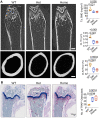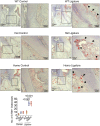Murine IRF8 Mutation Offers New Insight into Osteoclast and Root Resorption
- PMID: 38343385
- PMCID: PMC10985390
- DOI: 10.1177/00220345231222173
Murine IRF8 Mutation Offers New Insight into Osteoclast and Root Resorption
Abstract
Interferon regulatory factor 8 (IRF8), a transcription factor expressed in immune cells, functions as a negative regulator of osteoclasts and helps maintain dental and skeletal homeostasis. Previously, we reported that a novel mutation in the IRF8 gene increases susceptibility to multiple idiopathic cervical root resorption (MICRR), a form of tooth root resorption mediated by increased osteoclast activity. The IRF8 G388S variant in the highly conserved C-terminal motif is predicted to alter the protein structure, likely impairing IRF8 function. To investigate the molecular basis of MICRR and IRF8 function in osteoclastogenesis, we generated Irf8 knock-in (KI) mice using CRISPR/Cas9 technique modeling the human IRF8G388S mutation. The heterozygous (Het) and homozygous (Homo) Irf8 KI mice showed no gross morphological defects, and the development of hematopoietic cells was unaffected and similar to wild-type (WT) mice. The Irf8 KI Het and Homo mice showed no difference in macrophage gene signatures important for antimicrobial defenses and inflammatory cytokine production. Consistent with the phenotype observed in MICRR patients, Irf8 KI Het and Homo mice demonstrated significantly increased osteoclast formation and resorption activity in vivo and in vitro when compared to WT mice. The oral ligature-inserted Het and Homo mice displayed significantly increased root resorption and osteoclast-mediated alveolar bone loss compared to WT mice. The increased osteoclastogenesis noted in KI mice is due to the inability of IRF8G388S mutation to inhibit NFATc1-dependent transcriptional activation and downstream osteoclast specific transcripts, as well as its impact on autophagy-related pathways of osteoclast differentiation. This translational study delineates the IRF8 domain important for osteoclast function and provides novel insights into the IRF8 mutation associated with MICRR. IRF8G388S mutation mainly affects osteoclastogenesis while sparing immune cell development and function. These insights extend beyond oral health and significantly advance our understanding of skeletal disorders mediated by increased osteoclast activity and IRF8's role in osteoclastogenesis.
Keywords: NFATC Transcription Factors; dental biology; genetic animal models; genetic mutation; human association studies; osteoclasts.
Conflict of interest statement
Declaration of Conflicting InterestsThe authors declared no potential conflicts of interest with respect to the research, authorship, and/or publication of this article.
Figures





Similar articles
-
Inactivating Mutation in IRF8 Promotes Osteoclast Transcriptional Programs and Increases Susceptibility to Tooth Root Resorption.J Bone Miner Res. 2019 Jun;34(6):1155-1168. doi: 10.1002/jbmr.3690. Epub 2019 Mar 6. J Bone Miner Res. 2019. PMID: 30840779 Free PMC article.
-
SH3BP2 cherubism mutation potentiates TNF-α-induced osteoclastogenesis via NFATc1 and TNF-α-mediated inflammatory bone loss.J Bone Miner Res. 2014 Dec;29(12):2618-35. doi: 10.1002/jbmr.2295. J Bone Miner Res. 2014. PMID: 24916406 Free PMC article.
-
Epigenetic and transcriptional regulation of osteoclast differentiation.Bone. 2020 Sep;138:115471. doi: 10.1016/j.bone.2020.115471. Epub 2020 Jun 8. Bone. 2020. PMID: 32526404 Review.
-
Early estrogen-induced gene 1 facilitates osteoclast formation through the inhibition of interferon regulatory factor 8 expression.FASEB J. 2020 Sep;34(9):12894-12906. doi: 10.1096/fj.202001197R. Epub 2020 Aug 2. FASEB J. 2020. PMID: 32741026
-
[Suppressive effects for osteoclastogenesis regulated by RANKL signal].Clin Calcium. 2011 Aug;21(8):1141-7. Clin Calcium. 2011. PMID: 21814018 Review. Japanese.
Cited by
-
The multiple roles of interferon regulatory factor family in health and disease.Signal Transduct Target Ther. 2024 Oct 9;9(1):282. doi: 10.1038/s41392-024-01980-4. Signal Transduct Target Ther. 2024. PMID: 39384770 Free PMC article. Review.
-
Human dental follicle stem cell-derived exosomes reduce root resorption by inhibiting periodontal ligament cell pyroptosis.Stem Cell Res Ther. 2025 Feb 21;16(1):79. doi: 10.1186/s13287-025-04216-6. Stem Cell Res Ther. 2025. PMID: 39985080 Free PMC article.
-
Unravelling the Oral-Gut Axis: Interconnection Between Periodontitis and Inflammatory Bowel Disease, Current Challenges, and Future Perspective.J Crohns Colitis. 2024 Aug 14;18(8):1319-1341. doi: 10.1093/ecco-jcc/jjae028. J Crohns Colitis. 2024. PMID: 38417137 Free PMC article. Review.
References
-
- Bigley V, Maisuria S, Cytlak U, Jardine L, Care MA, Green K, Gunawan M, Milne P, Dickinson R, Wiscombe S, et al.. 2017. Biallelic interferon regulatory factor 8 mutation: a complex immunodeficiency syndrome with dendritic cell deficiency, monocytopenia, and immune dysregulation. J Allergy Clin Immunol. 141(6):2234–2248. - PMC - PubMed
-
- Darcey J, Qualtrough A. 2013. Resorption: part 1. Pathology, classification and aetiology. Br Dent J. 214(9):439–451. - PubMed
Publication types
MeSH terms
Substances
Grants and funding
LinkOut - more resources
Full Text Sources
Miscellaneous

